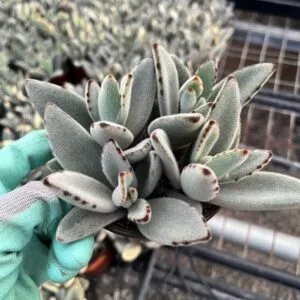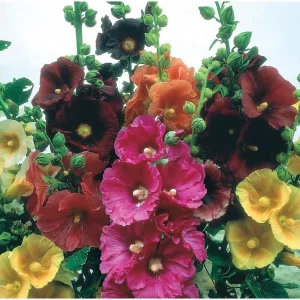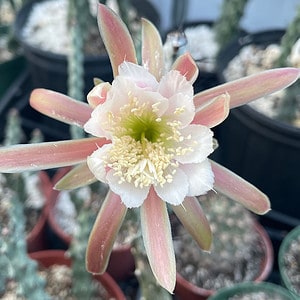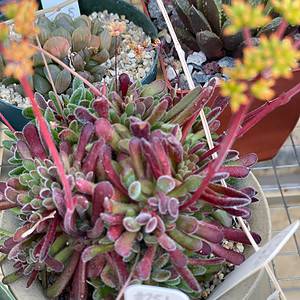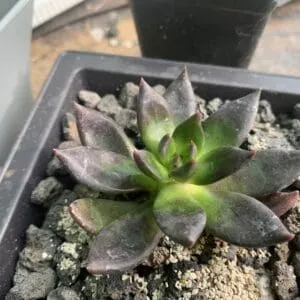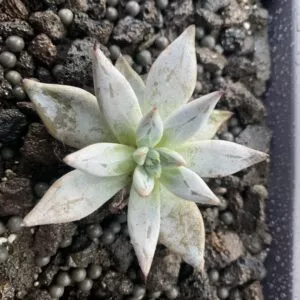No products in the cart.
Table of Contents
Did you know that the name Fatsia Japonica is Yatsude in Japanese, which means “eight hands”? “Fatsi” comes from an ancient Japanese word, “eight,” alluding to the plant’s eight lobes.
The architectural shape of Fatsia Japonica is renowned, as is the stunning evergreen foliage instead of the white flower it blooms.
These gleaming, hand-shaped leaves are smaller at the top and broader toward the bottom. This allows the leaves to absorb as much sunshine as possible, even in a dark location!
Another interesting fact about this plant is that it is a cross between Hedera helix and Fatshedera lizei. This plant can be used indoors in your house and can reach six feet.
The plant can also be an aesthetic plant serving as a formaldehyde absorber. Want to add this to your collection but don’t know how to take care of it? Well, don’t worry.
Plantly is the right place! Read more below.
Fatsia Japonica Plant Care Basics
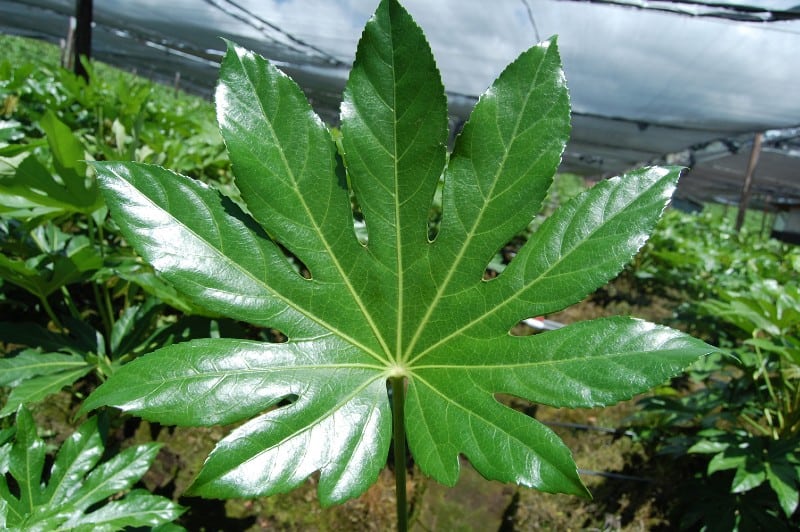
Before we give you the care basics of this plant, please look at its overview.
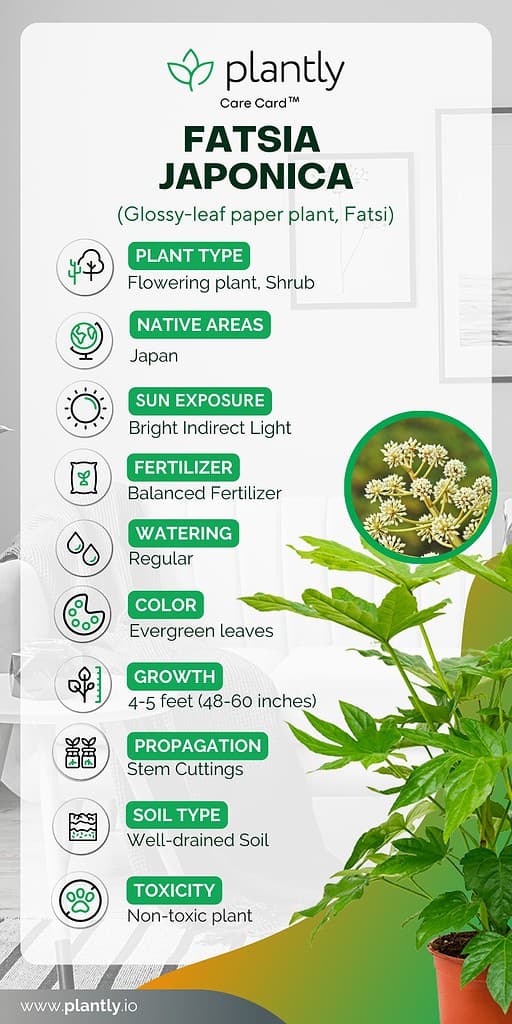
Now that we’ve introduced you to this exotic plant let’s look at the paper plant basic care with the tips provided.
False Castor Oil Plant Soil
The Japanese aralia, or Fatsia, is a popular ornamental plant that can thrive in various soil conditions. To ensure healthy growth and development, consider your plant’s soil requirements. Fatsia japonica prefers soil that drains well.
It doesn’t like sitting in waterlogged soil, which can lead to root rot. Ensure the ground has good drainage to prevent excess moisture around the roots. While well-draining soil is essential, the evergreen shrub does best in consistently moist soil.
It’s not drought-tolerant, so it’s essential to keep the soil consistently moist but not soggy. Your plant, Japanese aralia, thrives in soil with a slightly acidic to neutral pH range. A pH level between 6.0 and 7.5 is ideal for this plant.
Incorporating organic matter into the soil is beneficial for Fatsia japonica. Compost or well-rotted manure can improve the soil’s structure and fertility. This helps with moisture retention and nutrient availability.
If you’re growing Japanese aralia in a container, use a well-draining potting mix formulated for ornamental plants. Container plants may require more frequent watering and fertilization.
Watering Japanese Aralia Fatsia Japonica
The plant should be watered frequently enough to keep the soil moist. The Japanese Aralia requires consistent moisture during the growing season in Summer and Summer.
Watering often keeps the soil from drying up, saturating it entirely until water flows out of the drainage holes in the container. Reduce watering during the fall and winter to enable the plant to rest.
Pro tip: This plant needs to be watered carefully because it does not appreciate moist soil. The leaves will show you if it’s been overwatered by yellowing and dropping leaves.
Light For Japanese Aralia Plant

The paper plant is a shade-loving plant that thrives in low to moderate light conditions. In its natural habitat, it is often found under the canopy of trees, which means it’s adapted to grow in relatively low-light environments.
Your houseplant prefers dappled or filtered light, making it an excellent choice for areas with limited direct sunlight. It can be grown in areas that receive only indirect or partial sunlight.
This plant is well-suited for indoor growing, where it can be placed near windows with sheer curtains or in rooms with bright, indirect light.
Avoid placing the Japanese aralia in intense direct sunlight that can scorch its leaves. When cultivating your plant in the garden, it’s best to plant it in areas with partial to full shade.
It can tolerate some morning sun or dappled sunlight but should be protected from the harsh afternoon sun.
Excessive indoor exposure to direct sunlight can lead to leaf discoloration and damage, such as brown spots or sunburn on the leaves.
Pro tip: The variegated variety of the plant requires more light than the standard green plant.
Temperature Requirement
The Japanese aralia plant thrives in warmer environments, preferring 60–70 degrees Fahrenheit (15.5-21.1 degrees Celsius).
When the plant is dormant in the colder months, it also requires a cooler temperature of 45 to 55 degrees Fahrenheit (7 to 13 degrees Celsius).
Pro tip: Avoid placing this plant in any area of the house with a cold temperature or draft. If you reside in a chilly winter climate, keep this plant away from doorways that can get drafts.
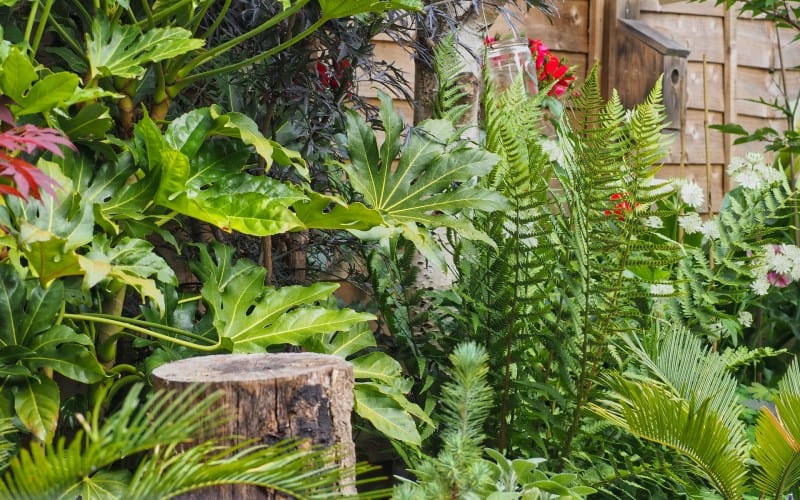
It does not require any additional humidity forms to thrive in your home, but it might benefit from some misting now and then. It is sufficient to have a humidity level of over 40%. You may learn how to improve humidity for your tropical houseplants in a few simple steps.
You can either group them or place a pebble tray.
Humidity Requirement
Japanese aralia does not require additional humidity to thrive in your home, but it might benefit from some misting occasionally. It is sufficient to have a humidity level of over 40%. Alternatively, group them with flowers and other plants or place a pebble tray.
False Castor Oil Plant Fertilizer
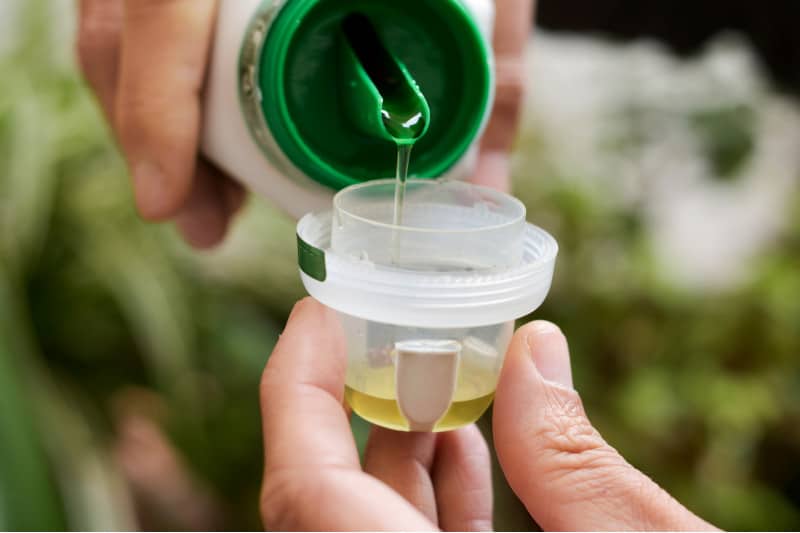
Feed your plant every two weeks in the growing season (spring and summer) using a half-diluted balanced liquid fertilizer to give your plant an extra nutritional boost. Depending on whether the plant has slowed or ceased growing during the winter months, reduce or eliminate fertilizer. When new growth begins in the spring, you can restart the process.
Pro tip: The plant’s yellow leaves suggest a shortage of nitrogen.
You can replicate this beauty in a few simple steps. And I know a beginner like you can make it a success! Japanese Aralia can be grown through stem cuttings.
Step-by-Step Procedure:
Choose a healthy plant to take tip cuttings. It’s best to take cuttings during the growing season, typically in the spring and summer.
Use clean, sharp pruning shears to take stem cuttings. Each cutting should be about 4 to 6 inches long and include a few leaves. Cut just below a node (where a leaf or bud is attached to the stem).
While it’s unnecessary, dipping the cut end of each stem in rooting hormone can help promote root development. Shake off any excess hormones.
Plant the cuttings in a small pot filled with well-draining potting mix. Make a hole in the potting mix with a pencil or your finger and insert the cutting, ensuring that at least one node is below the soil. You can plant multiple cuttings in the same pot, spacing them a few inches apart.
Water the cuttings thoroughly. Then, cover the pot with a plastic bag or a clear plastic dome to create a mini greenhouse environment. This helps maintain humidity around the cuttings.
Place the pot with cuttings in an area with bright, indirect light. Avoid direct sunlight, which can be too harsh for the newly planted cuttings. You can place the pot near a window with filtered light.
Check the cuttings regularly to ensure the soil remains moist but not soggy. You can use a spray bottle to mist the inside of the plastic cover to maintain humidity.
You should start seeing roots developing on the cuttings in a few weeks to a few months. You can gently tug the cuttings to check for resistance, indicating that roots have formed. Once the cuttings have established roots, they can be transplanted into individual pots as an indoor plant or in the garden.
Growth Zone

It’s a tropical plant that thrives in the warm climates of USDA plant hardiness zones 8 through 11.
Repotting Japanese Aralia
Keeping the Japanese aralia in mind and the mature size, it helps to choose a suitable container like a ceramic or terra-cotta pot. Otherwise, the top growth may be too heavy to keep a plastic pot from tipping.
Watching it when handled as an indoor plant or planted in a pot is also critical. Aralia japonica can get big. Once the Aralia has outgrown its pot, it must be re-potted to a bigger pot once a year. Ensure the pot has adequate drainage holes so that any extra water can drain rapidly.
Pruning Japanese Aralia
Because these plants can grow tall, don’t be afraid to prune them back. Fatsia must be pruned yearly to keep its bushy growth habit and glossy foliage. You can cut the entire Fatsia to the ground in late fall and winter too, just before new growth starts. To improve the appearance, trim leaf stems that extend too far beyond the plant.
Pro tip: You can propagate the tip cuttings by cutting your shrub back! Plus, the parent plant will grow bushier.
-
$9.00Sold By: Cacti and Exotica
In stock
Kalanchoe tomentosa—Panda Plant
Rated 4.98 out of 5 based on 59 customer ratings00Sold By: Cacti and Exotica -
Free Shipping$9.59Sold By: CZ Grain
In stock
Giant Danish Holyhock Seeds
Only 886 available and it’s in 1 people’s basketRated 4.60 out of 5 based on 156 customer ratings00Sold By: CZ Grain -
$19.95Sold By: Orchid Stuff Plus
$24.95In stock
A beautiful Royal Palm in a 4 inch pot.
Only 1 available and it’s in 1 people’s basketRated 5.00 out of 5 based on 1 customer rating00Sold By: Orchid Stuff Plus -
$18.00Sold By: Beauties & Beasts
In stock
Cactus – Monvillea spegazzinii
Only 2 available and it’s in 1 people’s basketRated 4.83 out of 5 based on 24 customer ratings00Sold By: Beauties & Beasts
Fatsia Japonica Varieties and Similar Plants
Looking for other similar plants like this beauty? We’ve provided some of them below that will surely catch your attention, and you will love to have them.
Anneise
This cultivar is distinguished by its bright colors, with deep emerald leaves flecked with radiant yellow. Anise is a simple plant to grow, with fluffy leaves on somewhat purple stems.
Moseri
The Moseri variety has huge blooms as well as large blackberries instead of tiny white flowers. It also blooms in the winter, from October to January, with its blossoms on display.
Spiders Web
The web-like speckles and veins that dot the leaves give this cultivar its name. The large, palmate leaves of this unusual evergreen have white splashing and dots. The plant’s variegation shifts with the seasons and as it grows older!
Fatsia Japonica Diseases & Pests
The Japanese Aralia is susceptible to a variety of pests. When the stem is still growing, these common pests attack the plant’s leaves heavily. The plant’s growth is stunted or hampered as a result of these attacks. That is why we will alarm you about them.
Pests
When cultivating Japanese Aralia at home, mealybugs are a problem. These white fuzzy bugs, which seem like little splotches of cotton or powder, can be found infesting the undersides of the leaves. Mealybugs are known to sip the fruits from the plant’s stem and leaves, taking all of the necessary nutrition for their survival.

You can eliminate mealybugs, aphids, and other pests from the plant by wiping the foliage with cotton swabs that have been lightly treated with rubbing alcohol. Another technique to keep them at bay is to apply neem tree oil, which naturally repels them.
Diseases
Etiolation is a frequent Fatsia japonica illness. The leaves turn green and yellow as etiolation takes place. Fatsia Japonica yellow illness can be caused by various factors, including iron deficiency or other factors. In general, when breeding, you need to improve management and apply fertilizer on time to prevent yellow disease.
The octagonal disc leaf spot disease is a summer-only illness that mainly damages leaves. It causes spots on the leaves to form and expand continually and eventually causes the leaves to wither. In terms of treatment, you need to focus on improving ventilation, applying more organic fertilizer, and eradicating the mites as soon as possible.
Frequently Asked Questions
Fatsia japonica is known for its large, glossy, deep green leaves with multiple lobes. It produces small, white flowers in late fall, followed by decorative black fruits. It can grow as a shrub or small tree.
When growing Fatsia japonica outdoors, grow it in a shaded area or where it receives partial, filtered sunlight. Please protect it from the harsh afternoon sun, especially in hot climates.
Fatsia japonica is considered relatively hardy but may suffer in freezing temperatures. It’s best to grow it in containers as an indoor plant in colder regions during winter months.
Yes, Fatsia japonica can be grown as a houseplant, but it should be placed in a room with bright, indirect light and protected from direct sun. Ensure the potting medium is well-draining and keep it consistently moist.
Fatsia japonica is considered mildly toxic to pets if ingested. It’s best to keep it out of reach of cats and dogs.
Regularly check the plant for pests, provide proper watering, and ensure it has a suitable environment with the right light conditions. Pruning can also help maintain its shape and size.
Whether you want to buy, sell, or simply reach out to other plant enthusiasts, Plantly is the right place to be!
-
$18.00Sold By: Beauties & Beasts
In stock
Succulent- Crassula pubescens subsp. pubescens
Only 2 available and it’s in 2 people’s basketRated 4.83 out of 5 based on 24 customer ratings00Sold By: Beauties & Beasts -
Free Shipping$35.95 – $40.95Sold By: A&K Plants
In stock
Peperomia Prostrata ‘String of Turtles’ | 4-inch pot
Only 11 available and it’s in 1 people’s basketRated 4.95 out of 5 based on 66 customer ratings00Sold By: A&K Plants -
$10.00Sold By: Emerald Dragon Greenhouse
Only 1 left in stock
Affinis Black knight
Rated 5.00 out of 5 based on 15 customer ratings00Sold By: Emerald Dragon Greenhouse -
$35.00Sold By: Emerald Dragon Greenhouse
$40.00Only 1 left in stock
Ungelica “Devils Claw”
Rated 5.00 out of 5 based on 15 customer ratings02Sold By: Emerald Dragon Greenhouse
